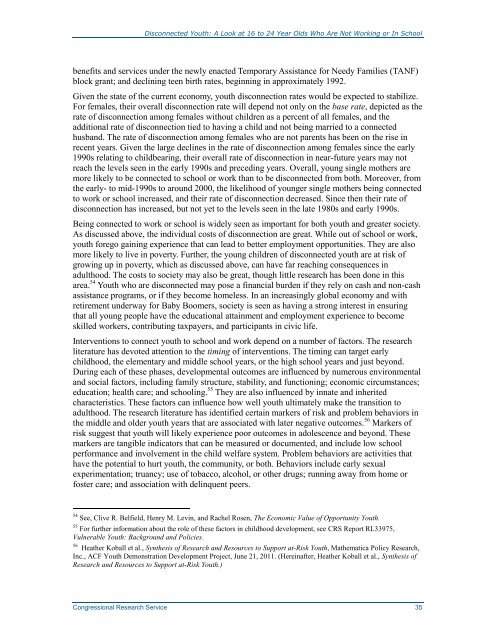Opportunity Youth: Disenfranchised Young People
Opportunity Youth: Disenfranchised Young People
Opportunity Youth: Disenfranchised Young People
Create successful ePaper yourself
Turn your PDF publications into a flip-book with our unique Google optimized e-Paper software.
Disconnected <strong>Youth</strong>: A Look at 16 to 24 Year Olds Who Are Not Working or In School<br />
benefits and services under the newly enacted Temporary Assistance for Needy Families (TANF)<br />
block grant; and declining teen birth rates, beginning in approximately 1992.<br />
Given the state of the current economy, youth disconnection rates would be expected to stabilize.<br />
For females, their overall disconnection rate will depend not only on the base rate, depicted as the<br />
rate of disconnection among females without children as a percent of all females, and the<br />
additional rate of disconnection tied to having a child and not being married to a connected<br />
husband. The rate of disconnection among females who are not parents has been on the rise in<br />
recent years. Given the large declines in the rate of disconnection among females since the early<br />
1990s relating to childbearing, their overall rate of disconnection in near-future years may not<br />
reach the levels seen in the early 1990s and preceding years. Overall, young single mothers are<br />
more likely to be connected to school or work than to be disconnected from both. Moreover, from<br />
the early- to mid-1990s to around 2000, the likelihood of younger single mothers being connected<br />
to work or school increased, and their rate of disconnection decreased. Since then their rate of<br />
disconnection has increased, but not yet to the levels seen in the late 1980s and early 1990s.<br />
Being connected to work or school is widely seen as important for both youth and greater society.<br />
As discussed above, the individual costs of disconnection are great. While out of school or work,<br />
youth forego gaining experience that can lead to better employment opportunities. They are also<br />
more likely to live in poverty. Further, the young children of disconnected youth are at risk of<br />
growing up in poverty, which as discussed above, can have far reaching consequences in<br />
adulthood. The costs to society may also be great, though little research has been done in this<br />
area. 54 <strong>Youth</strong> who are disconnected may pose a financial burden if they rely on cash and non-cash<br />
assistance programs, or if they become homeless. In an increasingly global economy and with<br />
retirement underway for Baby Boomers, society is seen as having a strong interest in ensuring<br />
that all young people have the educational attainment and employment experience to become<br />
skilled workers, contributing taxpayers, and participants in civic life.<br />
Interventions to connect youth to school and work depend on a number of factors. The research<br />
literature has devoted attention to the timing of interventions. The timing can target early<br />
childhood, the elementary and middle school years, or the high school years and just beyond.<br />
During each of these phases, developmental outcomes are influenced by numerous environmental<br />
and social factors, including family structure, stability, and functioning; economic circumstances;<br />
education; health care; and schooling. 55 They are also influenced by innate and inherited<br />
characteristics. These factors can influence how well youth ultimately make the transition to<br />
adulthood. The research literature has identified certain markers of risk and problem behaviors in<br />
the middle and older youth years that are associated with later negative outcomes. 56 Markers of<br />
risk suggest that youth will likely experience poor outcomes in adolescence and beyond. These<br />
markers are tangible indicators that can be measured or documented, and include low school<br />
performance and involvement in the child welfare system. Problem behaviors are activities that<br />
have the potential to hurt youth, the community, or both. Behaviors include early sexual<br />
experimentation; truancy; use of tobacco, alcohol, or other drugs; running away from home or<br />
foster care; and association with delinquent peers.<br />
54 See, Clive R. Belfield, Henry M. Levin, and Rachel Rosen, The Economic Value of <strong>Opportunity</strong> <strong>Youth</strong>.<br />
55 For further information about the role of these factors in childhood development, see CRS Report RL33975,<br />
Vulnerable <strong>Youth</strong>: Background and Policies.<br />
56 Heather Koball et al., Synthesis of Research and Resources to Support at-Risk <strong>Youth</strong>, Mathematica Policy Research,<br />
Inc., ACF <strong>Youth</strong> Demonstration Development Project, June 21, 2011. (Hereinafter, Heather Koball et al., Synthesis of<br />
Research and Resources to Support at-Risk <strong>Youth</strong>.)<br />
Congressional Research Service 35

















